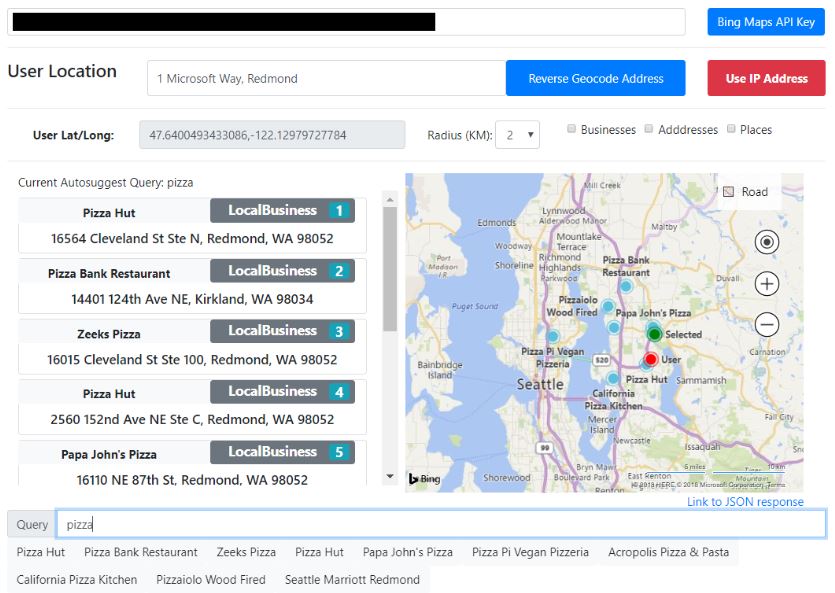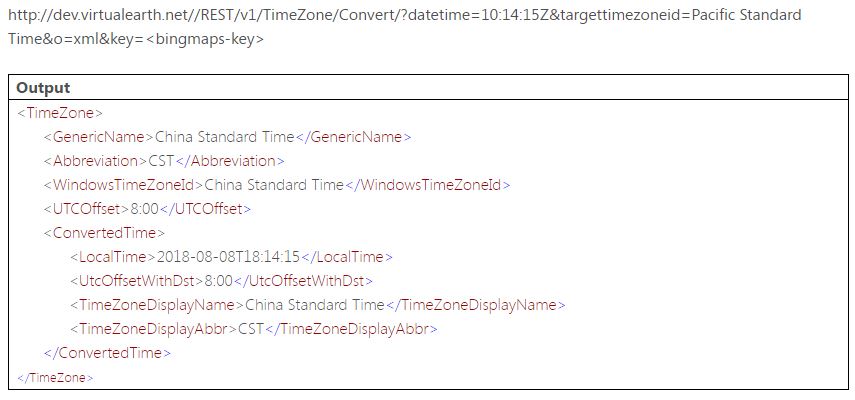The Microsoft Bing Maps announcements at Ignite 2018
Blog|by Mary Branscombe|13 November 2018

The aim with the Bing Maps APIs for developers is to try and offer ‘everything you can do with maps from soup to nuts’ says senior program manager Justine Coates. The new Local Search API (initiallly available in the US) announced at Ignite takes advantage of the knowledge graph that underlies the Bing search engine to make working with maps easier for end users. Instead of restricting searches to the specific business names entity types that Bing knows about, the API also allows free text search queries to get more targeted results from less precise search terms.
“If you’re looking for something to eat, you could always do that under one of the specific entity types like ‘restaurant’, but if you want to look for vegan, that’s not an entity type; you couldn’t find it under restaurant,” Coates explains. That fills in some surprising gaps, she notes. “Pizza is not an entity type!”
Local Search does what the name suggests and searches through what Bing knows about local businesses and produces a list of those that match the search query. The documentation for this will be online soon, but developers can mix and match entity search and query search together and fine tune the results by setting the radius or bounding box of the search and how many results to show.
Developers can also combine Local Search with other Bing Maps APIs, like the relatively new Isochrones service, to show all results within a distance radius but also highlight the ones that are within a five-minute drive.
Developers are coming up with new uses for the Isochrone API beyond the simple drive time highlighting it was designed for, Coates says. “If you have two people who both work who are house hunting, they can find house locations that have a decent commute to both workplaces by making an isochrone that overlaps.”
Isochrones don’t have to be contiguous, especially for public transport travel times. “A transit isochrone will have bubbles on the map,” she explains. “If you say you’re willing to travel for 30 minutes and there’s a train or other transit line, the Isochrone API will choose places that are at transit hubs where the journey only takes 30 minutes and return multiple polygons.”
Other recently introduced Bing Maps APIs make it easier to help users find what they’re looking for quickly and easily, even when they’re not specifically searching.
The AutoSuggest REST API returns a list of up to ten entities that match a partial query so users can type just the first few letters of a long business name or address and get location results; that works for road names and addresses, places and (initially in the US only and worldwide later) businesses. Use optional parameters like a search radius or bounding regions on the map, as well as the user’s location to rank the list of results (although results aren’t guaranteed to fall within those regions). Developers can choose how many suggestions to return (the default is 7), limit them to location types or restrict them to one country. Because users get results after typing just a few letters, the AutoSuggest API is designed to be called multiple times using the same user location but different searches; if they don’t get the place they’re looking for on the first time, people will try again with a slightly different search.
AutoSuggest is handy for speeding up form filling on ecommerce sites by letting the user type in one field and have the rest of the address added automatically, or helping them select a location for search.

An example of an ecommerce online ordering form showing how the Autosuggest API can be used in JavaScript to populate a list of suggested addresses. Source: Microsoft
The Location Recognition API fills in more details about a specific location; give it a latitude and longitude to get a list of entities. That includes the reverse geocoded address, including the neighbourhood and street intersection, any points of interest (like mountains, beaches and lakes as well as hotels, restaurants, shopping malls and other business types), and (in the US initially) business names and the type of property at that location (residential or commercial).
Obviously, that’s useful for understanding what’s nearby, like the neighbourhood around a house for sale or a job someone is applying for, but knowing more about a place is useful in lots of ways. MileIQ uses it to make it easier for users to label where a trip starts or ends. Cortana can automatically create trips from past phone locations and the photos you took, using reverse geocoding to look up not just the location but landmarks and points of interest nearby. On Android, if you use the Swiftkey keyboard and type the name of a location in a message, the keyboard uses the Location Recognition API to pull in the business, address and landmark information using a single API call. That could be a smart link in the message with the address of the restaurant or landmark where you’re planning to meet someone, or extra information to give a geotagged photo more context than just a point on the map. It’s an intelligent API, so it takes the time of day into account, as well as using the popularity of a result and other cues.
The new Bing Maps Time Zone API retrieves the time zone for places by name or location and lets developers look up the local time and other time details for a specific time zone.

Given a time value in UTC format and a target time zone, the Bing Maps Time Zone API will return the local time in the target time zone. DST setting is automatically applied based on time of the year. Source: Microsoft
Developers can also take inspiration from some of the features on the Bing Maps public site like the new customisable destinations itinerary builder for UK and US cities. Choose a city and how many days you’re spending there to get an itinerary of attractions to visit, day by day that you can save or share; you can edit or reorder the list, adding extra days and places to visit.
To explore the range of APIs and see how to make them fit in with your own app or site with less manual work, Coates points developers at the interactive SDK where you can build API queries in a visual interface and copy the code out as HTML, JavaScript or TypeScript, and the Map Style Sheet Editor in the Microsoft Store, which lets you customise the appearance of the Bing Maps controls and get a style sheet to deliver that look.
If you have questions about integrating Bing Maps into your application or for more information for your use case, contact the Grey Matter cloud location services team for an obligation-free discussion: mapping@greymatter.com or +44 (0)1364 655 133.
Contact Grey Matter
If you have any questions or want some extra information, complete the form below and one of the team will be in touch ASAP. If you have a specific use case, please let us know and we'll help you find the right solution faster.
By submitting this form you are agreeing to our Privacy Policy and Website Terms of Use.
Mary Branscombe
Mary Branscombe is a freelance tech journalist. Mary has been a technology writer for nearly two decades, covering everything from early versions of Windows and Office to the first smartphones, the arrival of the web and most things in between.
Related News
Intel oneAPI 2024.1 A Milestone Release
What’s new in Intel oneAPI 2024.1 The 2024.1 release of Intel® Software Development Tools marks a major milestone for developers AND the entire software industry: the Intel® oneAPI DPC++/C++ Compiler has become the first compiler to fully support the SYCL...
ISV Partner Day Shortlisted for CRN Sales & Marketing Award
ISV Partner Day has been shortlisted for "Best Customer Event" at the CRN Sales & Marketing Awards
Microsoft 365 and Azure Security Tools: Microsoft Intune
In the second video in our series of short videos discussing Microsoft 365 and Azure security tools and concepts, our Microsoft experts cover off all you need to know about Microsoft Intune! Intune is a robust cloud-based solution to safeguard...
Women in Tech: A New Era | Roundtable
Fri 21 June 2024 5:00 pm - 11:30 pm BST
Get ready to shake it off (and network like nobody’s watching) because we’re hosting an exciting exclusive Women in Tech event with ESET that you won’t want to miss out on. Join us and share feedback, experiences and insights with...